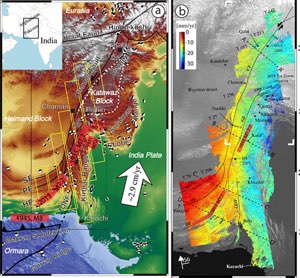Makran Subduction Zone
 This fault system in Pakistan and Afghanistan, which forms the plate boundary between the Indian and Eurasian plates, features some of the world’s largest continental strike-slip faults. InSAR data and careful analysis of the uncertainties, shows that the Chaman Fault proper features a 340 km long creeping segment and accommodates only about one third of the plate boundary zone deformation [Fattahi & Amelung,2016]. The fastest moving fault is the Ghazaband Fault, posing a significant earthquake hazard to the city of Quetta.
This fault system in Pakistan and Afghanistan, which forms the plate boundary between the Indian and Eurasian plates, features some of the world’s largest continental strike-slip faults. InSAR data and careful analysis of the uncertainties, shows that the Chaman Fault proper features a 340 km long creeping segment and accommodates only about one third of the plate boundary zone deformation [Fattahi & Amelung,2016]. The fastest moving fault is the Ghazaband Fault, posing a significant earthquake hazard to the city of Quetta.
In another study we have shown that moderate earthquakes along the Ghazaband Fault can be followed by significant afterslip [Fattahi et al., 2015].
Chaman Fault System
 This fault system in Pakistan and Afghanistan, which forms the plate boundary between the Indian and Eurasian plates, features some of the world’s largest continental strike-slip faults. InSAR data and careful analysis of the uncertainties, shows that the Chaman Fault proper features a 340 km long creeping segment and accommodates only about one third of the plate boundary zone deformation [Fattahi & Amelung,2016]. The fastest moving fault is the Ghazaband Fault, posing a significant earthquake hazard to the city of Quetta.
This fault system in Pakistan and Afghanistan, which forms the plate boundary between the Indian and Eurasian plates, features some of the world’s largest continental strike-slip faults. InSAR data and careful analysis of the uncertainties, shows that the Chaman Fault proper features a 340 km long creeping segment and accommodates only about one third of the plate boundary zone deformation [Fattahi & Amelung,2016]. The fastest moving fault is the Ghazaband Fault, posing a significant earthquake hazard to the city of Quetta.
In another study we have shown that moderate earthquakes along the Ghazaband Fault can be followed by significant afterslip [Fattahi et al., 2015].
2010 Haiti earthquake
 The M7.2 Haiti earthquake was a reminder of the seismic activity in the Carribbean. Our study using InSAR and GPS suggests that the earthquake occurred on a blind fault within the Haiti fault and thrust belt and not on the well-known Enriquillio-Plantain Garden strike-slip fault further south. Our study implies that the accumulated along this major strike-slip fault was not relieved. See our Nature Geoscience paper.
The M7.2 Haiti earthquake was a reminder of the seismic activity in the Carribbean. Our study using InSAR and GPS suggests that the earthquake occurred on a blind fault within the Haiti fault and thrust belt and not on the well-known Enriquillio-Plantain Garden strike-slip fault further south. Our study implies that the accumulated along this major strike-slip fault was not relieved. See our Nature Geoscience paper.



 This fault system in Pakistan and Afghanistan, which forms the plate boundary between the Indian and Eurasian plates, features some of the world’s largest continental strike-slip faults. InSAR data and careful analysis of the uncertainties, shows that the Chaman Fault proper features a 340 km long creeping segment and accommodates only about one third of the plate boundary zone deformation [Fattahi & Amelung,2016]. The fastest moving fault is the Ghazaband Fault, posing a significant earthquake hazard to the city of Quetta.
This fault system in Pakistan and Afghanistan, which forms the plate boundary between the Indian and Eurasian plates, features some of the world’s largest continental strike-slip faults. InSAR data and careful analysis of the uncertainties, shows that the Chaman Fault proper features a 340 km long creeping segment and accommodates only about one third of the plate boundary zone deformation [Fattahi & Amelung,2016]. The fastest moving fault is the Ghazaband Fault, posing a significant earthquake hazard to the city of Quetta. The M7.2 Haiti earthquake was a reminder of the seismic activity in the Carribbean. Our study using InSAR and GPS suggests that the earthquake occurred on a blind fault within the Haiti fault and thrust belt and not on the well-known Enriquillio-Plantain Garden strike-slip fault further south. Our study implies that the accumulated along this major strike-slip fault was not relieved. See our Nature Geoscience paper.
The M7.2 Haiti earthquake was a reminder of the seismic activity in the Carribbean. Our study using InSAR and GPS suggests that the earthquake occurred on a blind fault within the Haiti fault and thrust belt and not on the well-known Enriquillio-Plantain Garden strike-slip fault further south. Our study implies that the accumulated along this major strike-slip fault was not relieved. See our Nature Geoscience paper.